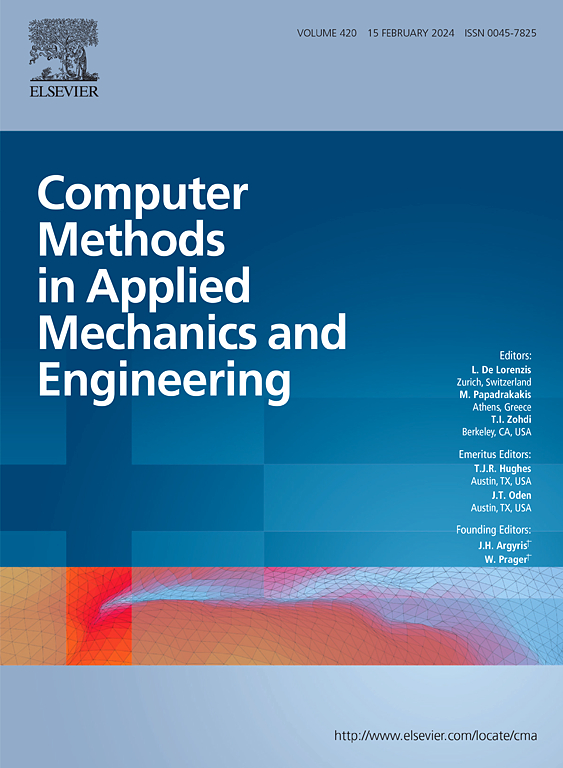TAEN:一种模型约束的正向和逆问题Tikhonov自编码器网络
IF 7.3
1区 工程技术
Q1 ENGINEERING, MULTIDISCIPLINARY
Computer Methods in Applied Mechanics and Engineering
Pub Date : 2025-07-31
DOI:10.1016/j.cma.2025.118245
引用次数: 0
摘要
在工程和科学应用中,有效的实时正逆问题求解器是必不可少的。机器学习代理模型已经成为传统方法的有前途的替代品,大大减少了计算时间。然而,这些模型通常需要广泛的训练数据集来实现跨不同场景的鲁棒泛化。虽然基于物理的方法可以部分减轻这种数据依赖性,并确保物理可解释的解决方案,但解决稀缺数据机制仍然是一个挑战。纯数据驱动和基于物理的机器学习方法在数据不足的情况下都会出现严重的过拟合问题。我们提出了一种新的模型约束的Tikhonov自编码器神经网络框架,称为TAEN,能够使用单个任意观测样本学习正向和逆代理模型。我们开发了全面的理论基础,包括线性情况下的正向和逆推理误差界。为了进行比较分析,我们推导了纯数据驱动和模型约束方法对应的等效公式。我们方法的核心是一种具有理论依据的数据随机化策略,它作为一种探索训练数据空间的生成机制,即使只有一次观察,也能有效地训练正向和反向代理模型,同时使学习过程规范化。我们通过两个具有挑战性的反问题的大量数值实验验证了我们的方法:二维导热系数反演和时变二维Navier-Stokes方程的初始条件重建。结果表明,TAEN分别在逆问题和正问题上实现了与传统Tikhonov求解器和数值正演求解器相当的精度,同时提供了数量级的计算速度。本文章由计算机程序翻译,如有差异,请以英文原文为准。
TAEN: a model-constrained Tikhonov autoencoder network for forward and inverse problems
Efficient real-time solvers for forward and inverse problems are essential in engineering and science applications. Machine learning surrogate models have emerged as promising alternatives to traditional methods, offering substantially reduced computational time. Nevertheless, these models typically demand extensive training datasets to achieve robust generalization across diverse scenarios. While physics-based approaches can partially mitigate this data dependency and ensure physics-interpretable solutions, addressing scarce data regimes remains a challenge. Both purely data-driven and physics-based machine learning approaches demonstrate severe overfitting issues when trained with insufficient data. We propose a novel model-constrained Tikhonov autoencoder neural network framework, called TAEN, capable of learning both forward and inverse surrogate models using a single arbitrary observational sample. We develop comprehensive theoretical foundations including forward and inverse inference error bounds for the proposed approach for linear cases. For comparative analysis, we derive equivalent formulations for pure data-driven and model-constrained approach counterparts. At the heart of our approach is a data randomization strategy with theoretical justification, which functions as a generative mechanism for exploring the training data space, enabling effective training of both forward and inverse surrogate models even with a single observation, while regularizing the learning process. We validate our approach through extensive numerical experiments on two challenging inverse problems: 2D heat conductivity inversion and initial condition reconstruction for time-dependent 2D Navier–Stokes equations. Results demonstrate that TAEN achieves accuracy comparable to traditional Tikhonov solvers and numerical forward solvers for both inverse and forward problems, respectively, while delivering orders of magnitude computational speedups.
求助全文
通过发布文献求助,成功后即可免费获取论文全文。
去求助
来源期刊
CiteScore
12.70
自引率
15.30%
发文量
719
审稿时长
44 days
期刊介绍:
Computer Methods in Applied Mechanics and Engineering stands as a cornerstone in the realm of computational science and engineering. With a history spanning over five decades, the journal has been a key platform for disseminating papers on advanced mathematical modeling and numerical solutions. Interdisciplinary in nature, these contributions encompass mechanics, mathematics, computer science, and various scientific disciplines. The journal welcomes a broad range of computational methods addressing the simulation, analysis, and design of complex physical problems, making it a vital resource for researchers in the field.

 求助内容:
求助内容: 应助结果提醒方式:
应助结果提醒方式:


